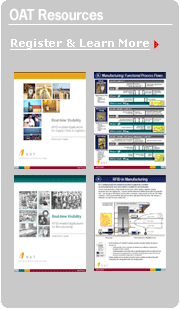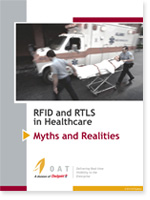
Hospitals have been an "early adopter" of RTLS asset tracking, monitoring the location of medical equipment in patient rooms. Now primary care providers are deploying asset tracking in more diversified settings and applications, from inventory management of consumables and supplies to process compliance in central sterile and in-house testing labs. The following table lists some of the most common business processes for RFID and RTLS in a hospital setting:
RFID and RTLS Applications in Hospitals
| Application: |
Assets Tracked: |
Why RFID / RTLS Asset Tracking?: |
Performance Metrics: |
| EQUIPMENT TRACKING |
• Medical Equipment
• Testing Equipment
• Facilities Equipment
• Manufacturing Equipment
• IT Assets |
• High value assets, high cost of capital
• Poorly-maintained assets can compromise quality of care and patient safety
• Improved operational efficienc
• High cost of compliance audits |
• Significant reduction in duplicate inventory & rental equipment
• More efficient staff allocation
• Streamlined documentation/ recordkeeping
• Reduction in service parts inventory
• Fewer manufacturing, logistics quality issues due to poorly maintained equipment |
| TEMPERATURE MONITORING & STERILIZATION |
• Surgical Instruments
• Scopes
• Vaccine
• Medical Specimens
• Perishable Materials
• Medical Devices |
• Labor-intensive paperwork, documentation processes
• Risk of compromising patient safety, drug efficacy
• Material waste
• Risk of regulatory fines |
• Improved processing time, without compromising safety
• Streamlined documentation
• Reduction in logistical errors, and associated costs
• Increased efficiency and auditability |
| CONSUMABLES TRACKING / INVENTORY MANAGEMENT |
• Medical Supplies
• Surgical Tray
• Medicatio
• Controlled Substances |
• Distributed inventory stores, often with excess inventory
• Labor-intensive inventory counting and documentation processes
• Product waste and risk to patient safety due to expired items |
• Reduction in product inventory, waste
• More efficient staff allocation
• Streamlined documentation/ recordkeeping |
| STAFF & PATIENT TRACKING |
• Medical Staff
• Patients |
• Over-scheduled staff
• Patients with high fall risk, flight risk |
• Improved staff support, patient care
• Reduction in errors |
|
Automating Central Sterile Processes with RFID
One of the fastest-growing RFID application areas is sterile instrument processing, specifically monitoring the intake, inspection, sterilization and kitting of surgical instruments and scopes. A simplified process for medical scopes is illustrated below:

For a recent RFID in Healthcare event, OAT created a poster-sized Infographic which describes key areas for RFID Process Automation in Healthcare with corresponding performance metrics. Download the Infographic here or by clicking on the thumbnail below.


![]()







 OAT Foundation Suite
OAT Foundation Suite






